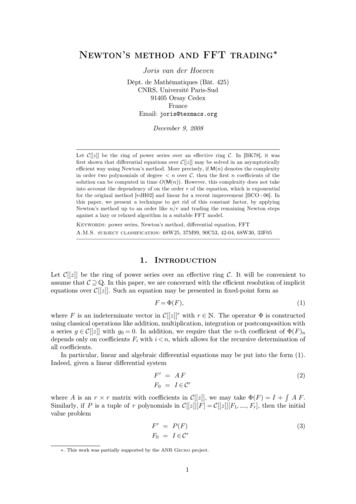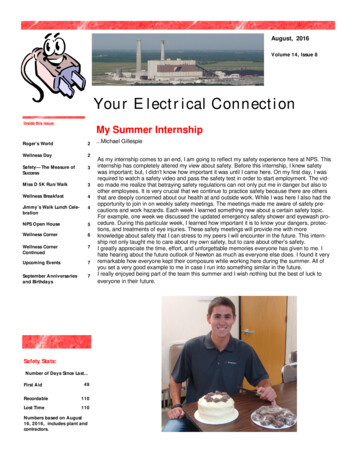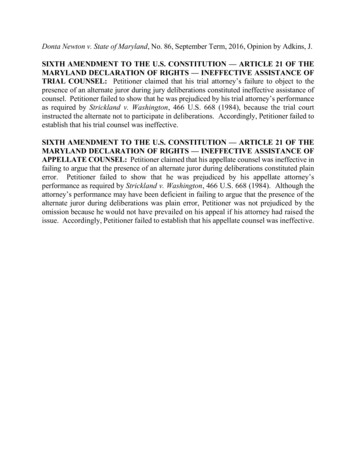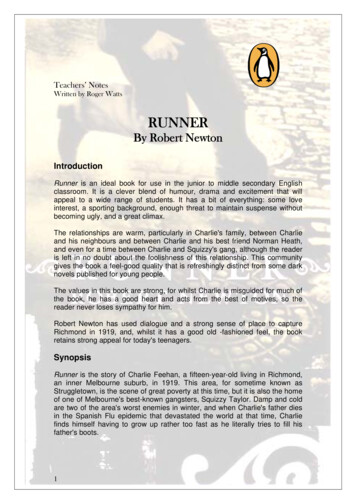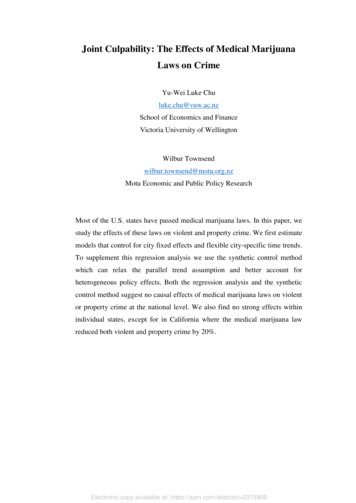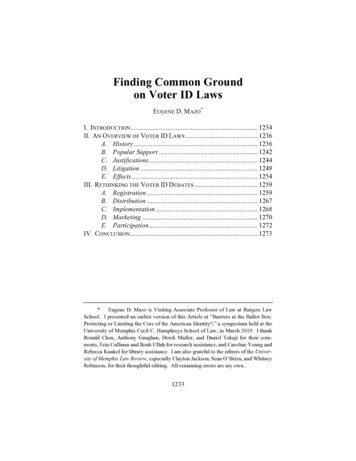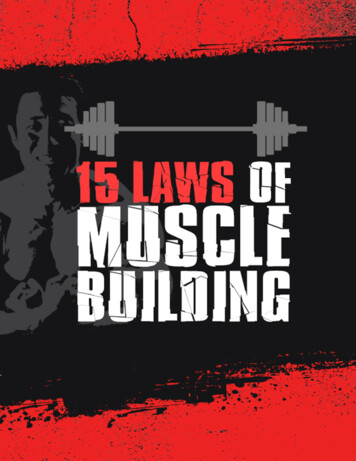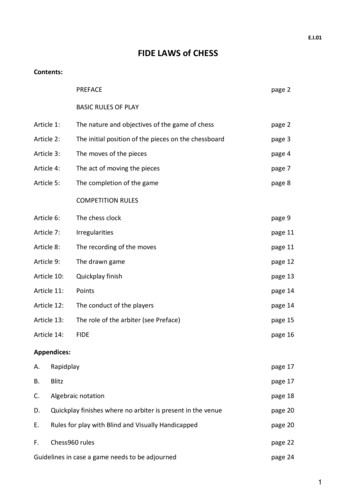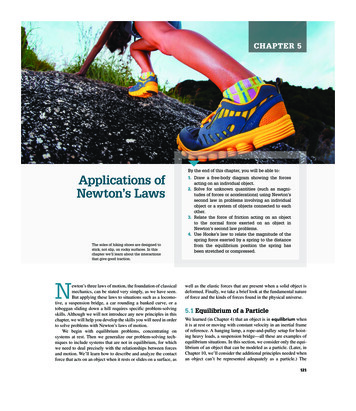
Transcription
Chapter 5Applications ofNewton’s LawsThe soles of hiking shoes are designed tostick, not slip, on rocky surfaces. In thischapter we’ll learn about the interactionsthat give good traction.Newton’s three laws of motion, the foundation of classicalmechanics, can be stated very simply, as we have seen.But applying these laws to situations such as a locomotive, a suspension bridge, a car rounding a banked curve, or atoboggan sliding down a hill requires specific problem-solvingskills. Although we will not introduce any new principles in thischapter, we will help you develop the skills you will need in orderto solve problems with Newton’s laws of motion.We begin with equilibrium problems, concentrating onsystems at rest. Then we generalize our problem-solving techniques to include systems that are not in equilibrium, for whichwe need to deal precisely with the relationships between forcesand m otion. We’ll learn how to describe and analyze the contactforce that acts on an object when it rests or slides on a surface, asBy the end of this chapter, you will be able to:1. Draw a free-body diagram showing the forcesacting on an individual object.2. Solve for unknown quantities (such as magnitudes of forces or accelerations) using Newton’ssecond law in problems involving an individualobject or a system of objects connected to eachother.3. Relate the force of friction acting on an o bjectto the normal force exerted on an object in Newton’s second law problems.4. Use Hooke’s law to relate the magnitude of thespring force exerted by a spring to the distancefrom the equilibrium position the spring hasbeen stretched or compressed.well as the elastic forces that are present when a solid object isd eformed. Finally, we take a brief look at the fundamental natureof force and the kinds of forces found in the physical universe.5.1 Equilibrium of a ParticleWe learned (in Chapter 4) that an object is in equilibrium whenit is at rest or moving with constant velocity in an inertial frameof reference. A hanging lamp, a rope-and-pulley setup for hoisting heavy loads, a suspension bridge—all these are examples ofequilibrium s ituations. In this section, we consider only the equilibrium of an object that can be modeled as a particle. (Later, inChapter 10, we’ll consider the additional principles needed whenan object can’t be represented adequately as a particle.) The121M05 YOUN2788 10 SE C05 121-151.indd 1219/12/14 2:52 PM
122CHAPTER 5 Applications of Newton’s Laws essential physical principle is Newton’s first law: When an object is at rest or movingwith constant velocity in an inertial frame of reference, the vector sum of all the forcesacting on it must be zero. That is (as discussed in Chapter 4), we have the followingprinciple:Necessary condition for equilibrium of an objectFor an object to be in equilibrium, the vector sum of the forces acting on it must bezero:ug F 0.(4.3)This condition is sufficient only if the object can be treated as a particle, which we assume throughout the remainder of this chapter.Notes:S An object in equilibrium must have a 0. An object in equilibrium may be at rest or moving with a constant velocity. Equation 4.3 is always applied to a single object on which the forces are acting.Equation 4.3 is actually more useful in component form when we work specific problems:Equilibrium conditions in component formAn object is in equilibrium if the sum of the components of the force in each axisdirection is zero:g Fx 0, g Fy 0.(4.4)Notes: You are free to choose any coordinate system for determining the components of theforces. The components of the forces can be either positive or negative depending on thecoordinate system and the direction of the respective force vectors.The primary objective of this chapter is to help you develop the skills necessary forsolving force problems. We strongly recommend that you study carefully the strategies thatfollow, look for their applications in the worked-out examples, and then try to apply themwhen you solve problems.Problem-Solving Strategy 5.1 ApplicationEasy does it!This crane is unloading a 50 ton, 8.2 metermirror for the European Southern Observatory in Antofagasta, Chile. It is one of four suchmirrors that make up an instrument known asthe Very Large Telescope, one of the world’sbiggest, most advanced optical telescopes.The crane holds the mirror steady, so that itremains in equilibrium with the vector sum ofthe forces on it equal to zero. However, thatdoes not ensure the mirror’s safety because itis not a particle. The forces acting on different parts of it are not the same. Warping ordeforming would be disastrous. The mirror isheavy in part because it is heavily reinforced.M05 YOUN2788 10 SE C05 121-151.indd 122in equilibriumSolving problems involving an objectSet Up1. Draw a simple sketch of the apparatus or structure, showing all relevant dimensionsand angles.2. Identify the object or objects in equilibrium that you will consider.3. Draw a free-body diagram for each object identified in step 2.a. Assuming that the object can be modeled as a particle, you can represent it by alarge dot. Do not include other objects (such as a surface the object may be resting on or a rope pulling on it) in your free-body diagram.b. Identify all the ways in which other things interact with the object, either bytouching it or via a noncontact force such as gravity. Draw a force vector torepresent each force acting on the object. Do not include forces exerted by theContinued9/12/14 2:52 PM
5.1 Equilibrium of a Particle123object. For each force, make sure that you can answer the question “What otherobject interacts with the chosen object to cause that force?” If you can’t answerthat question, you may be imagining a force that isn’t there.c. Label each force as a vector using a symbol that represents the magnitude of theforce (w for the object’s weight, n for a normal force, T for a tension force, etc.);indicate the directions with appropriate angles. (If the object’s mass is given, usew mg to find its weight.)4. Choose a set of coordinate axes, and represent each force acting on the object interms of its components along those axes. Cross out each force that has been replaced by its components, so that you don’t count it twice. You can often simplifythe problem by using a particular choice of coordinate axes. For example, when anobject rests or slides on a plane surface, it is usually simplest to take the axes in thedirections parallel and perpendicular to this surface, even when the plane is tilted.Solve5. For each object, set the algebraic sum of all x components of force equal to zero. In aseparate equation, set the algebraic sum of all y components equal to zero. (Never addx and y components in a single equation.) You can then solve these equations for up totwo unknown quantities, which may be force magnitudes, components, or angles.6. If you are dealing with two or more objects that interact with each other, use Newton’sthird law to relate the forces they exert on each other. You need to find as many independent equations as the number of unknown quantities. Then solve these equationsto obtain the values of the unknowns. This part is algebra, not physics, but it’s anessential step.Reflect7. Whenever possible, look at your results and ask whether they make sense. When theresult is a symbolic expression or formula, try to think of special cases (particularvalues or extreme cases for the various quantities) for which you can guess what theresults ought to be. Check to see that your formula works in these particular cases.Think about what the problem has taught you that you can apply to other problemsin the future.Example 5.1One-dimensional equilibriumVideo Tutor SolutionNow let’s apply the problem-solving strategy outlined above to a simple one-dimensional equilibrium problem. A gymnast hangs from the lower end of a rope connected to an O-ring that is bolted to the ceiling. Theweights of the gymnast, the rope, and the O-ring are 500 N, 100 N, and 50 N, respectively. What are themagnitudes of the tensions at both ends of the rope?SolutionThese are action–reaction pairs.Set Up First we sketch the situation (Figure 5.1a). Then we drawthree free-body diagrams, for the gymnast, the rope, and the O-ring(Figure 5.1b, c, and d). The forces acting on the gymnast are her weight(magnitude 500 N) and the upward force (magnitude T1) exerted on herby the rope. We don’t include the downward force she exerts on therope because it isn’t a force that acts on her. We take the y axis to bedirected vertically upward, the x axis horizontally. There are no x components of force; that’s why we call this a one-dimensional problem. Figure 5.1 Our diagrams for this problem. We sketch the situation (a),plus free-body diagrams for the gymnast (b), rope (c), and O-ring (d).(a)(b)(c)(d)ContinuedM05 YOUN2788 10 SE C05 121-151.indd 1239/12/14 2:52 PM
124CHAPTER 5 Applications of Newton’s LawsSolve The gymnast is motionless, so we know that she is in equilibrium. Since we know her weight, we can use Equation 4.4, gFy 0,to find the magnitude of the upward tension T1 on her. This force pullsin the positive y direction. Her weight acts in the negative y direction,so its y component is the negative of the magnitude—that is, -500 N.Thus,gFy 0,As you probably expect, this force equals the gymnast’s weight. Theother forces on the rope are its own weight (magnitude 100 N) and theupward force (magnitude T2) exerted on its upper end by the O-ring.The equilibrium condition gFy 0 for the rope givesgFy T2 1- 100 N2 1- 500 N2 0(equilibrium of rope),T2 600 N.T1 1-500 N2 0(equilibrium of gymnast),Reflect The tension is 100 N greater at the top of the rope (where itT1 500 N.The two forces acting on the gymnast are not an action–reactionpair because they act on the same object.Next we need to consider the forces acting on the rope (Figure 5.1c).Newton’s third law tells us that the gymnast exerts a force on the ropethat is equal and opposite to the force it exerts on her. In other words,she pulls down on the rope with a force whose magnitude T1 is 500 N.Table 5.1 Approximate breakingstrengthsThin white string50 N144000 Nin. nylon clothesline ropemust support the weights of both the rope and the gymnast) than at thebottom (where it supports only the gymnast).Practice Problem: What is the magnitude of the force exerted by thebolt on the O-ring as the gymnast hangs from the bottom end of therope? Answer: 650 N.The strength of the rope in Example 5.1 probably isn’t a major concern. The breakingstrength of a string, rope, or cable is described by the maximum tension it can withstandwithout breaking. Some typical breaking strengths are listed in Table 5.1.11 mm Perlon mountaineering rope 3 * 104 N114 in. manila climbing rope6 * 104 N146 * 104 Nin. steel cableExample 5.2Two-dimensional equilibriumNow we will look at an example where several forces are acting on an object, but in this case the forcesare not all along the same axis. As shown in Figure 5.2a, a car engine with weight w hangs from a chainthat is linked at point O to two other chains, one fastened to the ceiling and the other to the wall. Findthe tension in each of the three chains, assuming that w is given and the weights of the chains themselvesare negligible.Video Tutor Solution60 T2T3OT1(a) Engine, chains, and ring(b) Free-bodydiagram for engine(c) Free-bodydiagram for ring O Figure 5.2ContinuedM05 YOUN2788 10 SE C05 121-151.indd 1249/12/14 2:52 PM
5.1 Equilibrium of a ParticleSolution125We can now use this result in the first equation:Set Up Figure 5.2b is our free-body diagram for the engine. Withoutfurther ceremony, we can conclude that T1 w. (Because we ignorethe weights of the chains, the tension is the same throughout the lengthof each chain.) The horizontal and slanted chains do not exert forces onthe engine itself because they are not attached to it, but they do exertforces on the ring (point O), where the three chains join. So let’s consider the ring as a particle in equilibrium; the weight of the ring itselfis negligible.In our free-body diagram for the ring (Figure 5.2c), we have threeforces T1, T2, and T3; their directions are specified by the vectors in thediagram. We add an x-y coordinate system and resolve the force withmagnitude T3 into its x and y components. Note that the downward forcewith magnitude T1 of the chain acting on the ring and the upward forcewith magnitude T1 of the chain acting on the engine are not an action–reaction pair.Solve We now apply the equilibrium conditions for the ring, writ-ing separate equations for the x and y components. (Note that x and ycomponents are never added together in a single equation.) We findthatgFx 0, T3 cos 60 1-T22 0,So we can express all three tensions as multiples of the weight w of theengine, which we assume is known. To summarize, we haveT1 w,T2 0.577 w,T3 1.155 w.If the engine’s weight is w 2200 N (about 500 lb), thenT1 2200 N,T2 10.577212200 N2 1270 N,T3 11.155212200 N2 2540 N.Reflect Each of the three tensions is proportional to the weight w; ifwe double w, all three tensions double. Note that T3 is greater than theweight of the engine. If this seems strange, observe that T3 must be largeenough for its vertical component to be equal in magnitude to w, so T3itself must have a magnitude larger than w.gFy 0, T3 sin 60 1-T12 0.Because T1 w, we can rewrite the second equation asT1w 1.155 w.T3 sin 60 sin 60 Example 5.3T2 T3 cos 60 11.155 w2 cos 60 0.577 w.Practice Problem: If we change the angle of the upper chain from 60 to 45 , determine the new expressions for the three tensions. Answers:T1 w, T2 w cos 45 sin 45 w, T3 w sin 45 12w.Car on a rampIn this example we will see how to handle the case of an object resting on an inclined plane. A car with a weightof 1.76 * 104 N rests on the ramp of a trailer (Figure 5.3a). The car’s brakes and transmission lock are released; only the cable prevents the car from rolling backward off the trailer. The ramp makes an angle of 26.0 with the horizontal. Find the tension in the cable and the force with which the ramp pushes on the car’s tires.Video Tutor SolutionWe replace the weightby its components.unuTauw Figure 5.3(a) Car on rampSolutionSet Up Figure 5.3b shows our free-body diagram for the car. Thethree forces exerted on the car are its weight (magnitude w), the tension in the cable (magnitude T), and the normal force with magnitude n exerted by the ramp. (Because we treat the car as a particle, we canlump the normal forces on the four wheels together as a single force.)(b) Free-body diagram for carWe orient our coordinate axes parallel and perpendicular to the ramp,and we replace the weight force by its components.Solve The car is in equilibrium, so we first find the components ofeach force in our axis system and then apply Newton’s first law. Tofind the components of the weight, we note that the angle a betweenContinuedM05 YOUN2788 10 SE C05 121-151.indd 1259/12/14 2:52 PM
126CHAPTER 5 Applications of Newton’s Lawsthe ramp and the horizontal is equal to the angle a between the weightvector and the normal to the ramp, as shown. The angle a is not measured in the usual way, counterclockwise from the x axis. To findthe components of the weight (wx and wy), we use the right trianglesin Figure 5.3b. We find that wx - w sin a and wy - w cos a. Theequilibrium conditions then give usgFx 0, T 1- w sin a2 0,Finally, inserting the numerical values w 1.76 * 104 N and a 26 ,we obtainT 11.76 * 104 N21sin 26 2 7.72 * 103 N,n 11.76 * 104 N21cos 26 2 1.58 * 103 N.Reflect To check some special cases, note that if the angle a is zero,gFy 0, n 1- w cos a2 0.then sin a 0 and cos a 1. In this case, the ramp is horizontal; nocable tension T is needed to hold the car, and the magnitude of the totalnormal force n is equal to the car’s weight. If the angle is 90 (the rampis vertical), then sin a 1 and cos a 0. In that case, the cable tension T equals the weight w and the normal force n is zero.We also note that our results would still be correct if the car wereon a ramp on a car transport trailer traveling down a straight highway ata constant speed of 65 mi h. Do you see why?T w sin a,n w cos a.Practice Problem: What ramp angle would be needed in order for thecable tension to equal one-half of the car’s weight? Answer: 30 .Be sure you understand how the signs are related to our choice of coordinate axis directions. Remember that, by definition, T, w, and nare magnitudes of vectors and are therefore positive.Solving these equations for T and n, we findExample 5.4Lifting granite and dumping dirtVideo Tutor SolutionLet us again look at an inclined plane problem, but this time one involving two objects that are tied together by a cable. Blocks of granite, each with weight w1, are being hauled up a 15 slope out of a quarry(Figure 5.4). For environmental reasons, dirt is also being dumped into the quarry to fill up old holes. Youhave been asked to find a way to use this dirt to move the granite out more easily. YouCartdesign a system that lets the dirt (weight w2, including the weight of the bucket) thatdrops vertically into the quarry pull out a granite block on a cart with steel wheels(total weight w1), rolling on steel rails. Ignoring the weight of the cable and frictionin the pulley and wheels, determine how the weights w1 and w2 must be related for15 the system to move with constant speed.Bucket Figure 5.4SolutionSet Up Figure 5.5a shows an idealized model for the system. We drawuntwo free-body diagrams, one for the dirt and bucket (Figure 5.5b) andone for the granite block on its cart (Figure 5.5c). In drawing the coordinate axes for each object, we’re at liberty to orient them differentlyfor the two objects; the choices shown are the most convenient ones.(But we must not change the orientation of the objects themselves.) Werepresent the weight of the granite block in terms of its components inthe chosen axis system. The tension T in the cable is the same throughout because we are assuming that the cable’s weight is negligible. (Thepulley changes the directions of the cable forces, but if it is frictionlessand massless, it can’t change their magnitudes.)Solve Each object is in equilibrium. Applying gFy 0 to the b ucket(Figure 5.5b), we find thatApplying gFx to the cart (Figure 5.5c), we getT 1- w22 0, T w2.uTCartuTBucket15 uw2uw1(a) Idealized model(b) Free-bodydiagram for bucket(c) Free-bodydiagram for cart Figure 5.5T 1- w1 sin 15 2 0, T w1 sin 15 .Equating the two expressions for T yieldsw2 w1 sin 15 0.26 w1.M05 YOUN2788 10 SE C05 121-151.indd 126Continued9/12/14 2:52 PM
5.2 Applications of Newton’s Second Law127Reflect If the weight w2 of the dirt and bucket totals 26% of theweight w1 of the granite block and cart, the system can move in eitherdirection with constant speed. In the real world, where friction tends tohold back the motion, would w2 need to be greater or less than 0.26 w1for the granite block to move up with constant speed?unuTCartuTPractice Problem: The system you have designed could also be usedto remove dirt from the quarry by letting the cart slide back down theincline. If the cart slides back down the incline at a constant speed,determine the total normal force n that the tracks apply to the wheels ofthe granite cart, as a fraction of w1. Answer: n w1cos 15 0.97 w1.Bucket15 uw2uw1(b) Free-bodydiagram for bucketd model(c) Free-bodydiagram for cart Figure 5.5 (continued)5.2 Applications of Newton’s Second LawWe’re now ready to discuss problems in dynamics, showing applications of Newton’s second law to systems that are not in equilibrium. Here’s a restatement of that law:Newton’s second lawAn object’s acceleration equals the vector sum of the forces acting on it, divided by itsmass. In vector form, we write this statement asg F ma.uu(4.7)However, we’ll usually use this relationship in its component form:g Fx max , g Fy may .(4.8)The following problem-solving strategy is similar to our strategy for solving e quilibriumproblems, presented in Section 5.1:Problem-Solving Strategy 5.2Using Newton’s second lawSet Up1. Draw a sketch of the physical situation, and identify the moving object or objects towhich you will apply Newton’s second law.2. Draw a free-body diagram for each chosen object, showing all the forces acting onthat object, as described in the strategy for Newton’s first law (Problem-SolvingStrategy 5.1). Label each force as a vector with the symbol that you will use to represent its magnitude. Usually, one of the forces will be the object’s weight; it is generally best to label this as mg. If a numerical value of mass is given, you can computethe corresponding weight.3. Show your coordinate axes explicitly in each free-body diagram, and then determinethe components of forces with reference to these axes. If you know the direction ofthe acceleration, it is usually best to take that direction as one of the axes. When yourepresent a force in terms of its components, cross out the original force so as notto include it twice. When there are two or more objects, you can use a separate axissystem for each object; you don’t have to use the same axis system for all the objects.But, in the equations for each object, the signs of the components must be consistentwith the axes you have chosen for that object.ContinuedM05 YOUN2788 10 SE C05 121-151.indd 127 ApplicationGravity-defying liquid?Although this container is on a level tabletop,the liquid inside is at a slant. How can thatbe? You may have guessed that the photoshows a demonstration of a simple liquidfilled accelerometer. As the container isaccelerated to the left, the surface of theliquid forms an angle with the horizontal.The tangent of the angle is proportional tothe acceleration. Can you verify that if thecontainer is 19.6 cm wide, the height of theliquid at the right end (in cm) above its levelwhen the apparatus is at rest will give theacceleration of the container itself, in metersper second squared?9/12/14 2:52 PM
128CHAPTER 5 Applications of Newton’s Laws4. Write the equations for Newton’s second law in component form: g Fx max andg Fy may (Equations 4.8). Be careful not to add x and y components in the sameequation.5. If more than one object is involved, repeat step 4 for each object.6. Use what you know about the motion to identify any components of the acceleration that must have a certain value, such as zero. For example, a block sliding on ahorizontal surface cannot have a vertical acceleration; therefore, you should set thevertical component of the acceleration to zero.7. Solve the equations to find the required unknowns.SolveReflect8. Check particular cases or extreme values of quantities, when possible, and comparethe results for these particular cases with your intuitive expectations. Ask yourself,“Does this result make sense?” Think about what the problem has taught you thatyou can apply to other problems in the future.Quantitative Analysis 5.1Pushing a box across the flooruuYou push a box across a horizontal floor with a force Fa that is angledbelow the horizontal, as shown in Figure 5.6. How does the magnitudeof the normal force from the floor compare to the weight of the box asyou push it?A. The normal force from the floor is less than the box’s weight.B. The normal force from the floor is equal to the box’s weight.C. The normal force from the floor is greater than the box’s weight.force must cancel out both the weight and the vertical component of Fa,which point downward. Therefore, the correct answer is C. (Notice thatit is not clear from the problem whether or not the horizontal component of the box’s acceleration is zero, but that doesn’t affect our answerfor this problem, since we are concerned only with what is going onvertically.)uFaSolution As the box slides horizontally across the floor, it doesn’tmove vertically. Therefore, the vertical component of the accelerationof the box must be zero. This means that the upward-pointing normalExample 5.5 Figure 5.6A simple accelerometerIn this example we will use Newton’s second law to calculate the acceleration of a key hanging in a car.You tape one end of a piece of string to the ceiling light of your car and hang a key with mass m on theother end of the string (Figure 5.7a). A protractor taped to the light allows you to measure the angle thestring makes with the vertical. Your friend drives the car while you make measurements. When the car has aconstant a cceleration with magnitude a toward the right, the string hangs at rest (relative to the car), makingan angle b with the vertical. (a) Derive an expression for the acceleration a in terms of the mass m and themeasured angle b. (b) In particular, what is a when b 45 ? When b 0?Video Tutor SolutionyuauTT cos bbuabMass m(a) Low-tech accelerometer Figure 5.7M05 YOUN2788 10 SE C05 121-151.indd 128xT sin buw mgu(b) Free-body diagramfor the keyContinued9/12/14 2:53 PM
5.2 Applications of Newton’s Second LawSolution129Rearranging terms, we obtainSet Up Our free-body diagram is shown in Figure 5.7b. The forcesacting on the key are its weight w mg and the string tension T. Wedirect the x axis to the right (in the direction of the acceleration) and they axis vertically upward.Solve Part (a): This problem may look like an equilibrium problem,but it isn’t. The string and the key are at rest with respect to the car, butthe car, string, and key are all accelerating in the x direction. Thus,there must be a horizontal component of force acting on the key, andso we use Newton’s second law in component form: gFx max andgFy may.We find the components of the string tension, as shown inFigure 5.7b. The sum of the horizontal components of force isgFx T sin b,and the sum of the vertical components isgFy T cos b 1-mg2.T sin b max, T cos b mg.When we divide the first equation by the second, we getax g tan b.The acceleration ax is thus proportional to the tangent of the angle b.Part (b): When b 0, the key hangs vertically and the acceleration iszero; when b 45 , ax g.Reflect We note that b can never be 90 because that would requirean infinite acceleration. We note also that the relationship between axand b doesn’t depend on the mass of the key, but it does depend on theacceleration due to gravity.Practice Problem: What is the angle b if the acceleration is g 2? Answer: 26.6 .The x component of the acceleration of the car, string, and key isax a, and the y component of acceleration is zero, sogFx T sin b max,gFy T cos b 1- mg2 may 0.Example 5.6Acceleration down a hillNow we are going to look at the problem of an object sliding down a frictionless inclined plane. Suppose atoboggan loaded with vacationing students (total weight w) slides down a long, snow-covered slope. The hillslopes at a constant angle a, and the toboggan is so well waxed that there is virtually no friction. Find thetoboggan’s acceleration and the magnitude n of the normal force the hill exerts on the toboggan.Video Tutor SolutionSolutionSet Up Figure 5.8a is our sketch for this problem. The only forc-es acting on the toboggan are its weight w and the normal force n(Figure 5.8b). The direction of the weight is straight downward, but thedirection of the normal force is perpendicular to the surface of the hill,at an angle a with the vertical. We take axes parallel and perpendicularto the surface of the hill and resolve the weight into x and y components.Solve There is only one x component of force, sogFx w sin a.From gFx max, we havew sin a max,and since w mg, the acceleration isax g sin a.The y component equation gives gFy n 1- mg cos a2. We knowthat the y component of acceleration is zero because there is no motionin the y direction. So gFy 0 and n mg cos a.Reflect The mass m does not appear in the expression for ax; thismeans that any toboggan, regardless of its mass or number of passengers, slides down a frictionless hill with an acceleration of g sin a.In particular, when a 0 (a flat surface with no slope at all), theM05 YOUN2788 10 SE C05 121-151.indd 129(a) The situation(b) Free-body diagram for toboggan Figure 5.8 Our diagrams for this problem. acceleration is ax 0, as we should expect. When the surface is vertical, a 90 and ax g (free fall).Note that the magnitude n of the normal force exerted on the toboggan by the surface of the hill 1n mg cos a2 is proportionalto the magnitude mg of the toboggan’s weight; the two are not equal, except in the special case where a 0.Practice Problem: At what angle does the hill slope if the accelerationis g 2? Answer: 30 .9/12/14 2:53 PM
130CHAPTER 5 Applications of Newton’s LawsExample 5.7An air track in a physics labNow we will work a problem involving two objects tied together by a string. Figure 5.9a shows a gliderwith mass m 1 that moves on a level, frictionless air track in a physics lab. It is connected by a string passingover a small frictionless pulley to a hanging weight with total mass m 2. The string is light and flexible, andit doesn’t stretch. Find the acceleration of each object and the tension in the string.Video Tutor Solutionm1m2(a) Apparatus Figure 5.9SolutionSet Up The two objects have different motions, so we need to draw aseparate free-body diagram and coordinate system for each, as shown inFigure 5.9b and c. We are free to use different coordinate axes for the twoobjects; in this case, it’s convenient to take the x direction to the right forthe glider and the y direction downward for the hanging weight. Then theglider has only an x component of acceleration (i.e., a1x a1, a1y 0),and the weight has only a y component (i.e., a2x 0, a2y a2). Thereis no friction in the pulley, and w
(b) Free-body diagram for engine (c) Free-body diagram for ring O As you probably expect, this force equals the gymnast’s weight. The other forces on the rope are its own weight (magnitude 100 N) and the upward force (magnitude T 2) exerted on its upper end by the O-ring. The e


